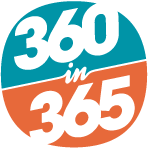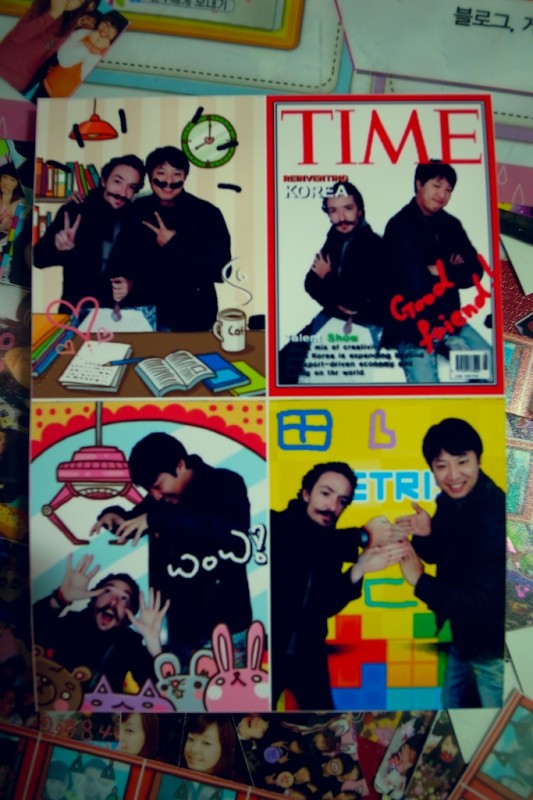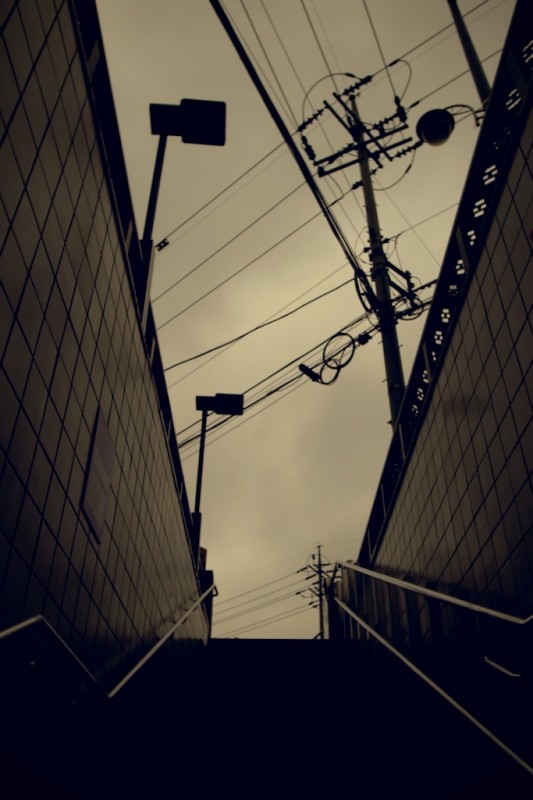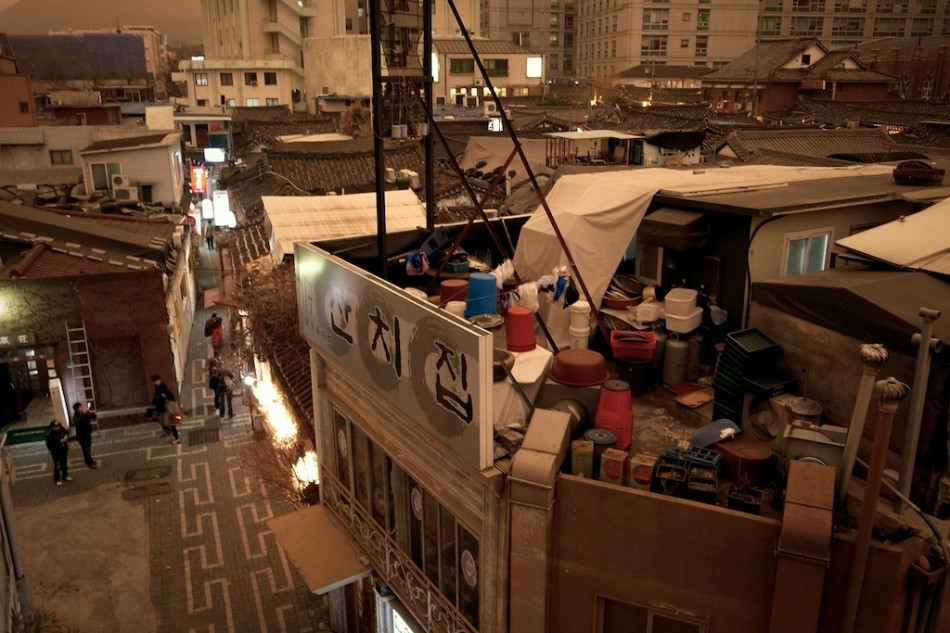Joachim has been traveling around the world. He left Paris on his 25th birthday, came back one year later in 2010. And you're here on his travel blog.
Since he came back, he started writing a book: 360 in 365 »
Cette page est aussi disponible en :
360 in 365 – Joachim voyage autour du monde

SEOUL, KR
Apr 12th, 2010
12:32 AM
Seoul
Two days ago I arrived in LA, during my longest day ever : I took my plane at 7 PM in Tokyo Narita on the 9th, and I arrived, 10 hours later, on the 9th at noon.
Three weeks ago I also arrived in a city where the climate was completely different. I left the bright sun of Manila (shrouded in pollution, of course) and I re-discovered a forgotten season in Seoul : winter. And Snow. Because, yep, in South Korea it can snow at the end of March.
I discovered Seoul with the help of my friend Min-Ho, a Korean guy I met in Bangkok thanks to a Korean freckled girl I had met in Laos. He hosted me, showed me around his area (near a big university, there’s lots of hip young people with glasses (very stylish but without lens), and very stylish coffee shops too), he visited some old royal palaces, some coffee shops and the museum dedicated to the old time king who invented the Hangeul alphabet.
This alphabet is the real pride of the Korean culture. It represents the identity of Korea in opposition to the “big brothers”, China and Japan. The king devised this alphabet to be more independant towards China, and to promote a bigger equality between classes. He created it in the utmost secret and presented it to the common and the learned people, and more or less said that if the learned people were not happy that their brothers could also read, he could very well cure that unhappiness with his sword. Common people were very happy. At last they didn’t need 20 years of study to be able to read spy novels. They would still have to wait a few centuries before they had spy novels, but anyway. The opportunity was there.
The Hangeul alphabet is very logical. The consonants are shaped like the mouth or the position of the tongue, and the design of the vowels is a reflexion on the four elements. The sounds AE, EE and OE are verical, but EU, U and OO are horizontal. Then you combine two or three of these letters together to form a syllab, and the design of a syllab is, like a chinese ideogram, to be written in the space of a square. So yeah, if you’re so very interested you can go check Wikipedia:Hangul. In the few days I spent with Min Ho I learned to read Korean, but just the sounds, so if I now learn the actual language, I’ll be able to read Stephen King in the Korean translation.
In Seoul, there’s Seoul Namsan Tower. In the middle of the city there’s a big hill with a park, it’s called Namsan mountain (San means mountain so it’s Nam-mountain mountain), and the mountain must not have been high enough, because they built a tower on it. And on this tower there’s the best toilets ever, when you’re a boy. You can pee looking at the city. In all the fantastic places I peed, this one might have been the most spectacular. I visited the tower with Min Ho and Jennifer, a Korean friend of Min Ho’s and of my freckled Korean friend. And we also saw, like I saw in Moscow or Huang Shan, and then in Osaka, a place where people put locks with their names on it, to symbolize Everlasting Love and what’s closed can never be open again. Or something like that.
Min-Ho introduced me to Korean cuisine… and I loved it, it’s so spicy! Kimchi, Bibimbap, Soju (local rice-based alcohol) (drink Chamiseul brand), korean grill, noodle soups, and, well, fresh octopus. Very fresh. It started with a request from my younger brother, who wanted me to reenact this famous scene from the movie Old Boy, where the hero eats a live octopus. But the right season for this kind of treats is in Summer, when the octopusses aren’t so big. So they cut mine in smaller pieces. The thing you should know about the nervous system of the octopus, is that every element is independant from the others. The arms still move when you cut them. So I had a plate full of octopus arms wiggling and wrestling and some spicy sauce. The video might be a little bit unsettling for the casual viewer, and even NSFW if your work doesn’t allow you to look at the adventures of a guy with a moustache and a live octopus.
YouTube – If you travel to Korea, try… the live octopus.
Seoul is an interesting city. Did you know for example that when a new building is built, 1% of the money spent in the construction must be devoted to a public artistic display? Everywhere you go, if you see a huge building there will be a sculpture or a work of Art. That’s a nice way to sponsor local artistic production… And speaking of local art, I also saw a group of young people playing music in the streets; but instead of being dirty hippies playing Bob (Marley) covers with a djembé, they were pretty good at playing rock with electric guitars and a girl tap-dancing to provide the beat. And then they stopped to read aloud the SMS their public sent them. Because there was a big sign with a phone number, and you could send an anonymous text message and they would read it aloud and comment it. The only message I understood was “I want to have your baby”. The rest was in Korean, but from what I saw from the people it got better and better. That’s actually a great way to interact with the public. They were not playing, or giving a show, they were having fun with people.
The city of Seoul has some old temples and palaces to visit, but not so many. The architecture could make think of Chinese architecture (like in the Forbidden City). Wood, paintings, roof tiles… The only real innovation (and they said it was a Korean invention) is the heating from the ground. Big fireplaces were in some corners of the building, and the air was thus heated and went below the wooden floors, providing heat to every place, and by every place I mean, only the throne room because wood is expensive and it’s a luxury to be warm when it’s so cold outside. So yeah it’s great to walk barefoot on it. And modern Koreans still build houses with ground heating and it’s veeeery nice.
Oh, and another Chinese thing they get in Korea, and it gets more and more frequent, is sand storms. The Gobi desert in Inner Mongolia is going eastwards thanks to the western winds and the deforestation. So when the sand comes to the Korean peninsula there’s a strange yellow light shrouding the city, giving us the impression to be on a strange planet amon people looking nearly like us, speaking a different language and writing things in a way you cannot read it. For real it’s not another planet, it’s called Seoul and I liked it.
6 Comments

All the contents on this website has been created by Joachim unless otherwise noted.
Copyrights and licenses - ©2009 Joachim
Served around the world by WordPress. Hosted by Dreamhost.
A Production Joachimesque



















La vidéo est vraiment … sympa, je pense que plus d’un serait dégouté,mais si un jour je fais un détour par séoul,je ne manquerais pas de tester ca ! :)
Comment by Jeremy (Dji Supertramp) — Apr 12th, 2010 @ 12:37 AM
Hahaha j’étais plié en regardant ta vidéo.
Vraiment sansass, me tarde d’aller en corée tester ça !
C’était des piments verts avec le poulpe ?
Comment by Naga_ — Apr 12th, 2010 @ 02:04 AM
ouai des petits piments qui bougeaient pas :) par contre, la tentacule quand tu la mets dans la sauce rouge piquante, ils se tortillent!
Comment by joachim — Apr 12th, 2010 @ 02:40 AM
Jolies photos et vidéo… intéressante !! :-)
Comment by RunningTracker — Apr 12th, 2010 @ 10:00 AM
Rah ça y est j’ai l’eau à la bouche!
Comment by Naga_ — Apr 15th, 2010 @ 05:42 AM
Brr… Ça me fait froid dans le dos… Ces poulpes qui se tortillent comme de petits saucissons…
Comment by P'pa — Apr 17th, 2010 @ 12:46 PM